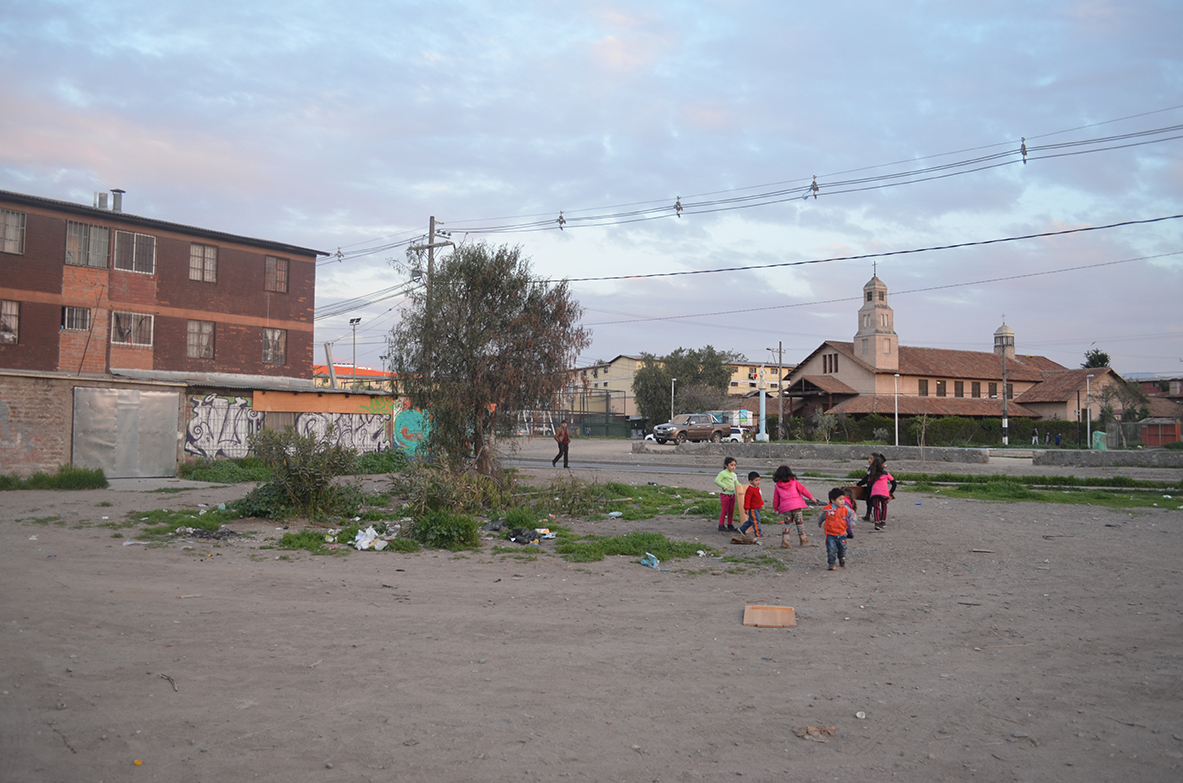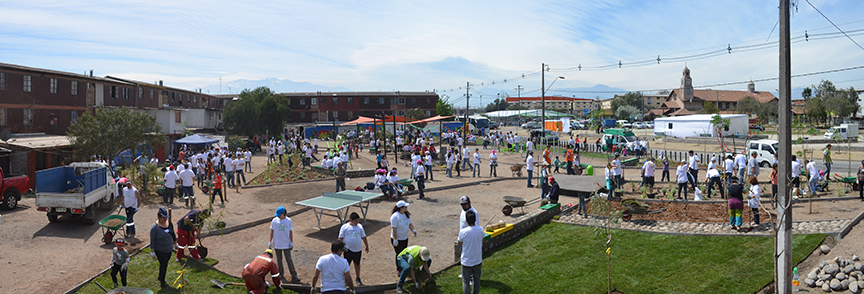
Before: Green space in dire need of repairs before Mi Parque Foundation reimagined and repurposed the outdoor area.
This nonprofit organization creates green spaces that improve the quality of life, generating safer and high standard community spaces in vulnerable neighborhoods of Chile.
In Latin America, the accelerated growth of main cities during the 60’s, forced government to focus its resources on providing housing and sanitary services for people, leaving public space development for future agendas. Consequently, over time, green areas were left as a second need overshadowed by more urgent demands such as health, education, job creation, and poverty among other public policies.
In other words, fiscal budgets aimed, first, to provide decent housing to inhabitants of Latin American countries, and particularly in Chile. Moreover, housing policies included the allocation of empty lots in urban projects so that in the future, they could be transformed into a green area for people to gather, enjoy community encounters, and the outdoors. In addition, urban policies became softer in favor of private investment, explains the Associate Researcher of the Urban Sustainable Development Center from Universidad Católica de Chile, Sonia Reyes: "Therefore, to make the private investment more attractive, public spaces requirements were deeply reduced, which also influenced the current deficit of green areas."
Unfortunately, in the last years and mainly in vulnerable neighborhoods, the lands designated to become future green areas during more prosperous years, ended up becoming abandoned areas converted, not only into illegal dumps, but also into negative spots with high crime rates and drug abuse. In this context, the private spaces gained more value while the public space is sometimes abandoned, without use, forcing families to be locked up in their own home with no out of doors space for recreation or interactions with neighbors.
Concerned about this social problem, which has a strong impact on the quality of life and dignity of people, the architects Julio Poblete and Martín Andrade, decided to make their dream come true of “everyone could feel proud of their neighborhood.” Therefore, they created the Mi Parque which means my park as a non-profit organization aimed at improving the quality of life in vulnerable neighborhoods through a participatory process of design, construction, and activation of green public areas.
"We work on public lands that, ironically, are green areas according to the Chilean regulatory plan, but when you arrive it is a gray point, that instead of being a place to gather, it is a focus of conflict that families avoid," says Carlos Aubert, current Executive Director of Mi Parque.
The center of the organization management is to work with the community who will use the future park, explains the executive director. It provides solutions tailored for each community’s characteristics and each urban context so that the public space is effectively used; besides strengthening the sense of ownership among the neighbors, which helps to motivate them to take care of the place that is being redesigned. "The restoration of a public space through a participatory methodology, allows us to recover the urban/social structure that makes up a neighborhood, having as center the needs of people from a community perspective," says Aubert.
To achieve the aforementioned objectives, Mi Parque has set up a work model where different actors participate in a collaborative way: the community that will use the future public space, the local government of the neighborhood, the work team of the organization, and a sponsoring company that will provide the financing and also participate with corporate volunteering during the construction of the future park.
Is important to consider that construction projects on public space can often be a long and complex process due to the amount of paperwork and permits involved. However, recovering green areas using a participatory process can be expeditious. This can be explained because municipalities approve the restoration of public spaces already destined as green areas. From the first meeting with the community who will occupy the square -- as a starting milestone -- until its construction, it lasts only 60 days approximately.
Once the land is identified in collaboration with local government and the funding is secured with a sponsoring company, the process, along with the beneficiary community, begins. It all starts with a kick-off meeting where Mi Parque professionals -- usually an architect and a social worker -- meet with neighbors and present the project. Subsequently, four workshops are held, starting from recognizing the uses of the space, the needs of the neighbors, and the community validation of the project. The design of the place is also discussed, so that it is consistent with the goals that are initially established together with the community.

After: La Esperanza’s Square, San Bernardo Commune, Metropolitan Region of Santiago, Chile, after renovation and preservation efforts by Mi Parque Foundation which redesigned the green space for public recreation to benefit the community.
The workshops conclude to give way to the day of the participative construction, that is the moment in which the square is built. That day people work on the space, previously intervened, including skilled labor and different actors -- neighbors, volunteers, the sponsoring company, and sometimes the local government -- to set the final details of this future meeting space. Grass, trees, and shrubs are planted, murals and furniture are painted, as well as the installation of other decorative ground elements such as maicillo, gravel, or decorative pine bark known as mulch.
This participation model is what Mi Parque claims to be the key to success: "through processes that manage to convene the neighbors, who know the identity of that place, raise needs and determine priorities, you can plan and build your own space, which represent the communities, thus ensuring a greater commitment in the use and maintenance of the new park. On the other hand, the relationship with the municipality commits them for future maintenance and, finally, the private company who, not only make an economic contribution to a purpose that has multiple social advantages, but also relate to the beneficiaries and work together for the same goal, which is different from one-way charitable initiatives," explains Carlos Aubert. While warning that, although it is a model that has been successful so far, "the challenge is to open other forms of financing, so that economic resources do not depend entirely on corporate giving."
In this nine-year history of Mi Parque, the financing model has differentiated itself from other non-profit organizations. Each project is financed by a company and it not only participates with resources, but also with volunteering. In addition, a long-term relationship is held, providing budget reports on the use of resources and the status of the current condition of the project, in terms of landscape, plants, outdoor furniture, or playground elements among others.
Regarding the performance of this model, in 2012, convinced that they were generating deep social changes and with the objective of critically evaluating their work, Mi Parque conducted an impact study of its participatory methodology with the non-profit research center of Latin America and the Caribbean, J-Pal and with the sponsorship of IM Trust. The study evaluated 28 pairs of public spaces -- one intervened by Mi Parque and the other as a control sample -- during three years, delivering empirical figures on the uses of the green areas.
Francisco Gallego, researcher at the Economics Institute of the Universidad Católica de Chile and scientific director of J-Pal, have presented the results highlighting that the improvement of use and maintenance of the square, as well as the environment: "renovated spaces were used 55 percent more by children under 12 years; and for those people over 12 years old and housewives the use increased by 50 percent and 76 percent, respectively. In addition, the frequency of which they reported garbage in the park decreased by 17 percent and there were 31 percent less appearances of scratches (on walls). Finally, the perception of security in the neighborhood increased by nine percent," says the expert.
With almost 300 green spaces built since 2008, the organization has benefited more than 470 thousand people in the 15 regions of the Chilean territory. The challenge is to continue working through this long and narrow country, and ideally in the future, to be able to expand this methodology to Latin America. Today, a project in another country in the region is being evaluated, hoping to continue collecting the needs, dreams, and common concerns of each community with its particular characteristics into a public space design. As Julio Poblete says, founder and president of the Directorio Mi Parque, "The integration and participation of all those who live in the city promises a better future."


